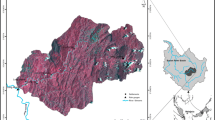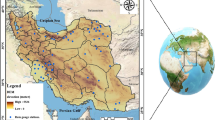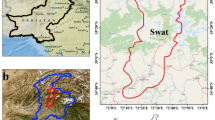Abstract
Vegetation cover is the main factor of soil loss prevention. The C-factor of the RUSLE (Revised Universal Soil Loss Equation) was predicted with NDVI, ground data and exponential regression equation for mountain rangelands of Kyrgyzstan. Time series of C-factor, precipitation and temperature were decomposed into seasonal and trend components with STL (seasonal decomposition by loess) to assess their interrelations. C-factor, precipitation and temperature trend components indicated significant lagged correlation, whereas seasonal components indicated more complex relations with climate factors which can be promoting as well as limiting factors for vegetation development, depending on the season. Rainy springs and hot summers may increase soil loss dramatically, whereas warm and dry springs with rainy summers can decrease it. Steep slopes indicated higher soil loss ratio, whereas flat areas were better protected by vegetation.
Similar content being viewed by others
References
Atkinson PM, Jeganathan C, Dash J, Atzberger C (2012) Intercomparison of four models for smoothing satellite sensor time-series data to estimate vegetation phenology. Remote Sensing of. Environment 123: 400–417. DOI: 10.1016/j.rse.2012.04.001
Blanco H, Lal R (2008) Principles of Soil Conservation and Management: Springer Science+Business Media B.V. p 626.
Borchardt P, Oldeland J, Ponsens J, et al. (2013) Plant functional traits match grazing gradient and vegetation patterns on mountain pastures in SW Kyrgyzstan.. Phytocoenologia 43: 171–181. DOI: 10.1127/0340-269X/2013/ 0043-0542
Borchardt P, Schickhoff U, Scheitweiler S, et al. (2011) Mountain pastures and grasslands in the SW Tien Shan, Kyrgyzstan: floristic patterns, environmental gradients, phytogeography, and grazing impact. Journal of Mountain. Science 8: 363–373. DOI: 10.1007/s11629-011-2121-8
Bradley BA, Jacob RW, Hermance JF, et al. (2007) A curve fitting procedure to derive inter-annual phenologies from time series of noisy satellite NDVI data. Remote Sensing of Environment 106: 137–145. DOI: 10.1016/j.rse.2006.08.002
Bradley BA, Mustard JF (2005) Identifying land cover variability distinct from land cover change: Cheatgrass in the Great Basin. Remote Sensing of. Environment 94: 204–213. DOI: 10.1016/j.rse.2004.08.016
Bühlmann E, Wolfgramm B, Maselli D, et al. (2010) Geographic information system–based decision support for soil conservation planning in Tajikistan. Journal of Soil and Water. Conservation 65: 151–159. DOI: 10.2489/jswc.65.3.151
Cleveland RB, Cleveland WS, McRae JE, et al. (1990) STL: A Seasonal-Trend Decomposition Procedure Based on Loess. Journal of Official Statistics 6: 3–73.
Cleveland WS, Grosse E, Shyu WM (1992) Local regression models. In: Chambers JM, Hastie TJ (eds.), Statistical Models in S. Chapman & Hall. pp 309–376.
Crewett W (2012) Improving the Sustainability of Pasture Use in Kyrgyzstan: The Impact of Pasture Governance Reforms on Livestock Migration. Mountain Research and. Development 32: 267–274. DOI: 10.1659/MRD-JOURNAL-D-11-00128.1
de Beurs K, Henebry G (2010) Spatio-Temporal Statistical Methods for Modelling Land Surface Phenology. In: Hudson IL, Keatley MR (eds.), Phenological Research. Springer Netherlands. pp 177–208.
de Jong R, de Bruin S, de Wit A, et al. (2011) Analysis of monotonic greening and browning trends from global NDVI time-series. Remote Sensing of. Environment 115: 692–702. DOI: 10.1016/j.rse.2010.10.011
de Jong SM (1994) Derivation of vegetative variables from a landsat tm image for modeling soil erosion. Earth Surface Processes and. Landforms 19: 165–178. DOI: 10.1002/esp. 3290190207
de Jong SM, Brouwer LC, Riezebos HT (1998) Erosion hazard assessment in the La Peyne catchment, France. Working Paper EU DeMon-II Project, i.o.v. EU. Utrecht University. The Netherlands (1998). p 27.
Dörre A, Borchardt P (2012) Changing systems, changing effects—Pasture utilization in the post-soviet transition: case studies from southwestern Kyrgyzstan. Mountain Research and. Development 32: 313–323. DOI: 10.1659/MRDJOURNAL-D-11-00132.1
Dotterweich M (2013) The history of human-induced soil erosion: Geomorphic legacies, early descriptions and research, and the development of soil conservation—A global synopsis.. Geomorphology 201: 1–34. DOI: 10.1016/j.geomorph.2013. 07.021
FAO (2006) World reference base for soil resources 2006 A framework for international classification, correlation and communication. Rome: Food and agriculture organization of the United Nations. p 145.
FAO (2011) FAOSTAT. Available online at: http://faostat3. fao.org/home/index.html>accessed on 17 May 2013.
Fu B, Liu Y, Lü Y, et al. (2011) Assessing the soil erosion control service of ecosystems change in the Loess Plateau of China. Ecological. Complexity 8: 284–293. DOI: 10.1016/j.ecocom. 2011.07.003
Gessner U, Naeimi V, Klein I, et al. (2013) The relationship between precipitation anomalies and satellite-derived vegetation activity in Central Asia. In: Global and Planetary. Change 110: 74–87. DOI: 10.1016/j.gloplacha.2012.09.007
Iwasaki H (2006a) Impact of interannual variability of meteorological parameters on vegetation activity over Mongolia. Journal of the Meteorological Society of Japan. Ser.. II, 84: 745–762. DOI: 10.2151/jmsj.84.745
Iwasaki H (2006b) Study on Influence of Rainfall Distribution on NDVI Anomaly over the Arid Regions in Mongolia Using an Operational Weather Radar.. SOLA 2: 168–171. DOI: 10.2151/sola.2006-043
Iwasaki H (2009) NDVI prediction over Mongolian grassland using GSMaP precipitation data and JRA-25/JCDAS temperature data. Journal of Arid Environments 73: 557–562. DOI: 10.1016/j.jaridenv.2008.12.007
Karaburun A (2010) Estimation of C factor for soil erosion modeling using NDVI in Buyukcekmece watershed. Ozean Journal of Applied. Sciences 3: 77–85.
Kariyeva J, van Leeuwen WJD (2012) Phenological dynamics of irrigated and natural drylands in Central Asia before and after the USSR collapse. Agriculture, Ecosystems &. Environment 162: 77–89. DOI: 10.1016/j.agee.2012.08.006
Korovin EP (1961) Vegetation of Middle (Central) Asia and South Kazakhstan. Tashkent, Akademy of Sciense of Uzbek SSR. p 452. (in Russian)
Law KH, Nichol J (2004) Topographic correction for differential illumination effects on Ikonos satellite imagery. Paper presented at the XXth International Society for Photogrammetry and Remote Sensing Congress: Geo-imagery bridging continents, Istanbul, Turkey.
Lee S (2004) Soil erosion assessment and its verification using the Universal Soil Loss Equation and Geographic Information System: a case study at Boun, Korea. Environmental. Geology 45: 457–465. DOI: 10.1007/s00254-003-0897-8
Li ZW, Zhang GH, Geng R, et al. (2015) Land use impacts on soil detachment capacity by overland flow in the Loess Plateau, China.. Catena 124: 9–17. DOI: 10.1016/j.catena. 2014.08.019
Lioubimtseva E, Cole R, Adams JM, et al. (2005) Impacts of climate and land-cover changes in arid lands of Central Asia. Journal of Arid. Environments 62: 285–308. DOI: 10.1016/j.jaridenv.2004.11.005
Mamytov AM (1974) Soils of Kyrgyz SSR. Frunze, Ilim. p 418. (in Russian)
Middendorff AF (1882) Insights in Fergana Valley. Saint Petersburg, Imperial Academy of Sciences. p 303. (in Russian)
Mikhailov DY (1959) Soil erosion in Kyrgyz SSR. Frunze, Kirgizgosizdat. p 190. (in Russian)
Nezlin NP, Kostianoy AG, Li BL (2005) Inter-annual variability and interaction of remote-sensed vegetation index and atmospheric precipitation in the Aral Sea region. Journal of Arid. Environments 62: 677–700. DOI: 10.1016/j.jaridenv.2005.01.015
Omuto CT, Vargas RR, Alim MS, et al. (2010) Mixed-effects modelling of time series NDVI-rainfall relationship for detecting human-induced loss of vegetation cover in drylands. Journal of Arid. Environments 74: 1552–1563. DOI: 10.1016/j. jaridenv.2010.04.001
Paudel KP, Andersen P (2010) Assessing rangeland degradation using multi temporal satellite images and grazing pressure surface model in Upper Mustang, Trans Himalaya, Nepal. Remote Sensing of. Environment 114: 1845–1855. DOI: 10.1016/j.rse.2010.03.011
Propastin PA, Kappas M, Muratova NR (2008a) Inter-annual changes in vegetation activities and their relationship to temperature and precipitation in Central Asia from 1982 to 2003. Journal of Environmental. Informatics 12: 75–87. DOI: 10.3808/jei.200800126
Propastin PA, Kappas M, Muratova NR (2008b) A remote sensing based monitoring system for discrimination between climate and human-induced vegetation change in Central Asia. Management of Environmental Quality: An International Journal 19: 579–596. DOI: 10.1108/14777830810894256
Renard KG, Foster GR, Weesies GA, et al. (1996) Predicting soil erosion by water: a guide to conservation planning with the revised universal soil loss equation (RUSLE) Washington, DC, USA. p 404.
Rigina O, Rasmussen MS (2003) Using trend line and principal component analysis to study vegetation changes in Senegal 1986–1999 from AVHRR NDVI 8 km data. Geografisk Tidsskrift-Danish Journal of. Geography 103: 31–42. DOI: 10.1080/00167223.2003.10649477
Sun W, Shao Q, Liu J, et al. (2014) Assessing the effects of land use and topography on soil erosion on the Loess Plateau in China.. Catena 121: 151–163. DOI: 10.1016/j.catena.2014. 05.009
Suriyaprasit M, Shrestha DP (2008) Deriving land use and canopy cover factor from remote sending and field data in inaccessible mountainous terrain for use in soil erosion modeling. Paper presented at the International Archives of the Photogrammetry, Remote Sensing and Spatial Information Sciences, Beijing, China.
van der Knijff JM, Jones RJA, Montanarella L (1999) Soil Erosion Risk Assessment in Italy. Joint Research Centre (European Commission), Space Applications Institute, European Soil Bureau (European Commission). p 58.
van der Knijff JM, Jones RJA, Montanarella L (eds.) (2000) Soil Erosion Risk Assessment in Europe. Joint Research Centre (European Commission), Space Applications Institute, European Soil Bureau (European Commission). p 38.
Verbesselt J, Hyndman R, Newnham G, et al. (2010) Detecting trend and seasonal changes in satellite image time series. Remote Sensing of. Environment 114: 106–115. DOI: 10.1016/j.rse.2009.08.014
Verbesselt J, Hyndman R, Zeileis A, et al. (2010) Phenological change detection while accounting for abrupt and gradual trends in satellite image time series. Remote Sensing of. Environment 114: 2970–2980. DOI: 10.1016/j.rse.2010.08. 003
Vykhodcev IV (1956) Vegetation of Pastures and Hayfields of Kirgiz SSR. Frunze, Academy of Science of Kirgiz SSR. p 336. (in Russian)
Wang B, Zhang GH, Shi YY, et al. (2014) Soil detachment by overland flow under different vegetation restoration models in the Loess Plateau of China.. Catena 116: 51–59. DOI: 10.1016/j.catena.2013.12.010
Wischmeier WH, Smith DD (1978) Predicting Rainfall Erosion Losses. Washington, DC, USA. p 69.
Yu F, Price KP, Ellis J, et al. (2003) Response of seasonal vegetation development to climatic variations in eastern central Asia. Remote Sensing of. Environment 87: 42–54. DOI: 10.1016/S0034-4257(03)00144-5
Zemlyanitzkiy LT (1937) About soil erosion in mountain areas of South Kirgizia and Uzbekistan In: Soil erosion (collection of articles). Moscow: Academy of Sciences of USSR. pp 59-67. (In Russian)
Zhou P, Luukkanen O, Tokola T, et al. (2008) Effect of vegetation cover on soil erosion in a mountainous watershed.. Catena 75: 319–325. DOI: 10.1016/j.catena.2008.07.010
Zhou ZC, Gan ZT, Shangguan ZP, et al. (2010) Effects of grazing on soil physical properties and soil erodibility in semiarid grassland of the Northern Loess Plateau (China). Catena 82: 87–91. DOI: 10.1016/j.catena.2010.05.005
Author information
Authors and Affiliations
Corresponding author
Additional information
http://orcid.org/0000-0002-2319-8705
http://orcid.org/0000-0003-1502-936X
http://orcid.org/0000-0002-2358-9933
Rights and permissions
About this article
Cite this article
Kulikov, M., Schickhoff, U. & Borchardt, P. Spatial and seasonal dynamics of soil loss ratio in mountain rangelands of south-western Kyrgyzstan. J. Mt. Sci. 13, 316–329 (2016). https://doi.org/10.1007/s11629-014-3393-6
Received:
Revised:
Accepted:
Published:
Issue Date:
DOI: https://doi.org/10.1007/s11629-014-3393-6




